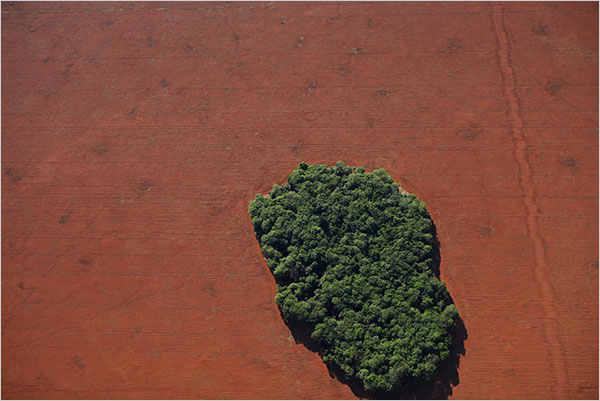You might wonder what you are seeing in this photograph:

Look closely, and you will see a clump of trees. Some might also recognize the even rows of high-tech, monocultural agriculture stretched across the plain. But I’ve given too much away, as you also could have seen a clump of mold or cells bunched together in some microscopic field. Beneath the surface, one might also “see” some more elemental social form such as herd animals pressing together for warmth or even an ark adrift in barren sea. Whatever it is, it is visually striking: one blot of rich green on a uniformly reddish-brown background etched with small modulations in black. Scale becomes elastic while form and color dominate in any register. There is something basic here, but what?
Perhaps some content would help. The caption in the New York Times read: “Small islands of forest dot the landscape of farms and ranches, fulfilling regulations to maintain percentages of native forest on agricultural properties. Driven by profits derived from fertile soil, the region’s dense forests have been aggressively cleared over the past decade, and Mato Grosso is now Brazil’s leading producer of soy, corn and cattle, exported across the globe by multinational companies.”
OK, it is a photograph of trees in a field. Trees saved to maintain a forestation quota, in a field of soybeans produced for the international commodity markets. The additional information and the political subtext are helpful, but a problem remains. Note how the photo’s ambiguity in scale is also there in the text. We are seeing something “small,” and also something that extends “across the globe.” And, sure enough, the story behind the picture is one that identifies the tension between localized benefits and global costs. Life might be simple if one could focus exclusively on one dimension or the other: manage the forests for the planet, or allow economic development wherever possible. But, of course, the problem is that both are needed. One has to be able to see both locally and globally, a bifocal vision that itself does not come cheap.
Some might argue that the picture is unfair. It looks as if only the trees are natural, whereas in a few months the entire field also would be a vibrant green. Frankly, “nature” is becoming an outmoded term, and protecting nature or biodiversity or carbon dioxide levels or any other ecological value involves both technological savvy and a recognition that life is everywhere, even in burning forests for commodity cropping. The photo is not so much fair or unfair, however, as it is profound. It captures something essential, a sense of what is at stake. That small island of trees can stand in for everything from a tiny cell to the planet itself, and the point is always the same: no matter what the scale, life on earth is a small, precious island amidst a void.
The image is ironic as well: trees having no need of human intervention evoke something like sympathy, whereas the field is an achievement of human productivity that will produce historically astonishing yields capable of feeding millions. But, of course, it’s not that simple. The fields will wither if the carbon dioxide levels get out of whack, and the deeper irony is that what feeds us can kill us. Just as indigenous peoples in the Amazon basin learn to discriminate poisons, medicines, and foods carefully in the forest, moderns need to learn to do the same in respect to their remaking of the forest. In each case, one needs to learn to see, but not in the same way.
In this case, the photograph provides one lesson in how to see modern development: as if cultured for observation, both up close and from a distance, on behalf of sustainable growth, and capable of extinction.
Photograph by Damon Winter/The New York Times.
An isolated clump of trees is in no way preserving nature. Plants and animals need large communities connected by corridors for travel between them.
This is an abomination, and what leads to desertification of the planet. Without trees to hold the moisture, these crops will soon be dying in drought anyway.